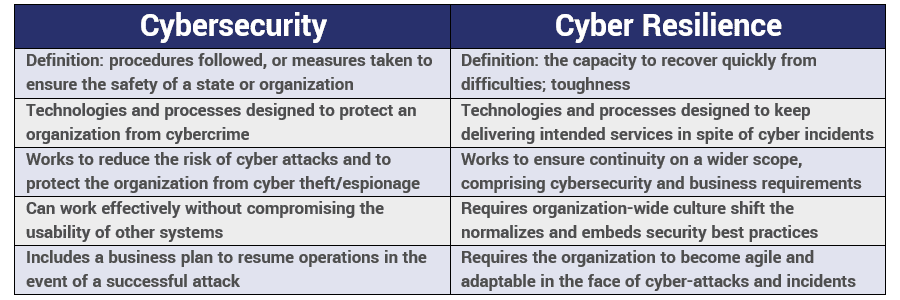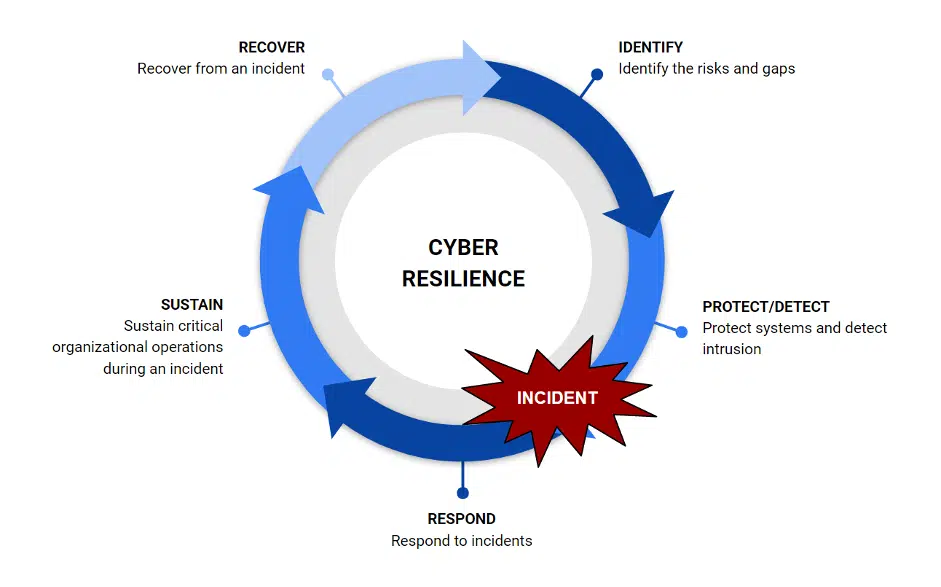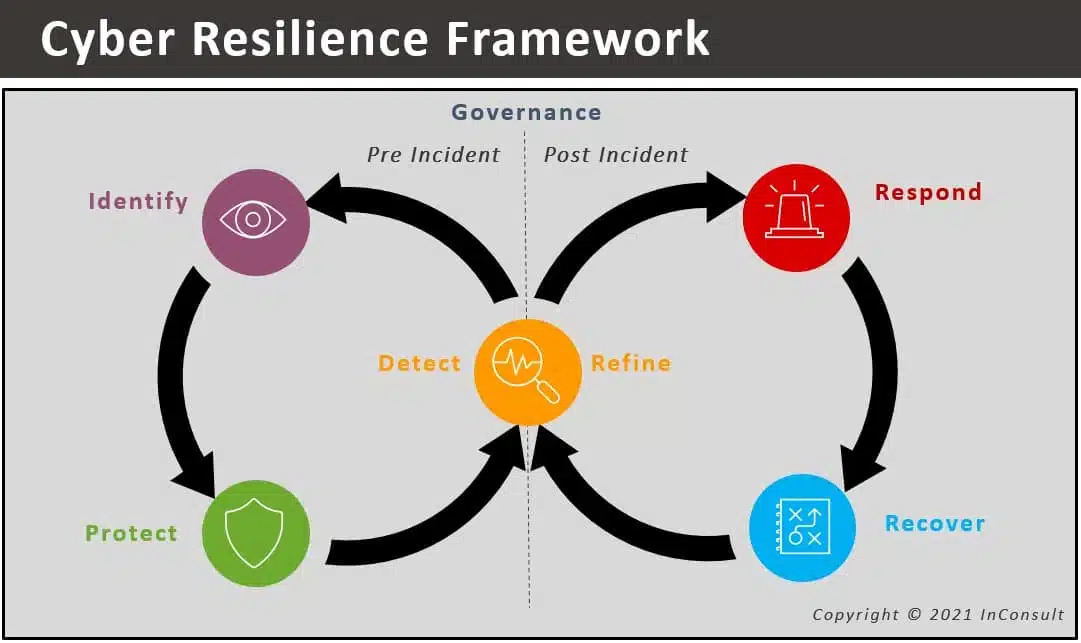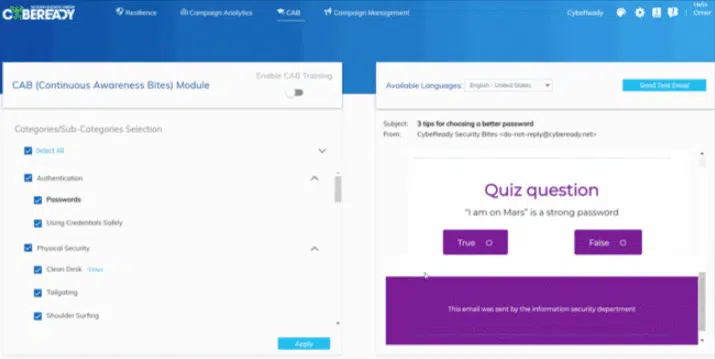Picture this: A manufacturing company renowned for its innovative products and impeccable reputation falls victim to a sophisticated cyberattack. Operations come to a screeching halt, confidential data is compromised, and customer trust hangs in the balance. This cautionary tale emphasizes the critical need for cyber resilience—the ability to withstand, respond to, and recover from cyberattacks.
While cybersecurity measures are essential, more is needed to protect organizations from the evolving nature of cyber threats. Close to 75% of organizations experience at least one cyberattack, and it’s up to every organization to ensure it has the necessary measures in place to keep its environment secure.
In this article, we’ll explore what cyber resilience is, the significance of a cyber resilience framework, and how to create one for your organization.
What is cyber resilience, and what is a cyber resilience framework?
Cyber resilience is an approach that organizations adopt to manage and mitigate cyber risks proactively. It involves building the organization’s capacity to continue operations and recover quickly from cyberattacks by implementing a cyber resilience framework. A framework provides structured guidelines and practices to enhance hardiness against cyber threats.
Cyber resilience is different than cybersecurity, which primarily focuses on preventing and protecting against attacks. Unlike cybersecurity, cyber resilience acknowledges that attacks are inevitable, and instead encompasses strategies for incident response, business continuity, risk management, and even employee training.
It’s also important to note that a cyber resilience framework is not the same as a cybersecurity strategy. While a cybersecurity strategy outlines the overall approach to safeguarding digital assets, a cyber resilience framework delves into the specific actions and processes necessary to maintain resilience. It includes detailed incident response plans, business continuity plans, risk assessments, ongoing monitoring, and evaluation.
Cyber Resilience Framework Benefits
Implementing a cyber resilience framework brings numerous benefits to organizations across industries, including:
- Strengthened Defense – A cyber resilience framework enhances your organization’s ability to identify and respond to cyber threats, reducing the likelihood of successful attacks.
- Business Continuity – Since it incorporates business continuity planning, a cyber resilience framework ensures minimal disruption to operations during and after a cyberattack, safeguarding your organization’s reputation and customer trust.
- Regulatory Compliance – Many industries, including finance, pharma, and manufacturing, are subject to strict regulatory requirements. A cyber resilience framework helps you meet these obligations and demonstrate your commitment to cybersecurity.
- Risk Reduction – A cyber resilience framework helps organizations proactively address potential risks by identifying and prioritizing vulnerabilities and threats. This proactive approach allows for the implementation of preventive measures to mitigate the likelihood of successful attacks.
- Improved Stakeholder Confidence – Demonstrating a robust cyber resilience framework instills confidence in stakeholders, including customers, partners, and investors. It showcases your organization’s commitment to protecting sensitive information, fostering trust and credibility in the marketplace.
- Cost Savings – Investing in cyber resilience can lead to significant cost savings in the long run. Organizations can avoid financial losses associated with disrupted operations, data breaches, and regulatory penalties by minimizing the impact of cyber incidents and reducing downtime.
- Competitive Advantage – A well-established cyber resilience framework can provide a competitive edge in the marketplace. It demonstrates your organization’s commitment to cybersecurity, giving you an advantage over competitors and positioning you as a trusted and reliable partner.
- Organizational Learning and Improvement – Implementing a cyber resilience framework involves continuously monitoring, evaluating, and improving cybersecurity measures. This process facilitates organizational learning, enabling you to adapt and strengthen defenses based on evolving threats and industry best practices.
3 Examples of Cyber Resilience Frameworks
1. NIST Cybersecurity Framework
This framework, created by the National Institute of Standards and Technology (NIST), provides a flexible and risk-based approach to managing and mitigating cyber risks. It emphasizes five core functions: Identify, Protect, Detect, Respond, and Recover.
2. ISO 27001
As part of the ISO 27000 series, ISO 27001 focuses on establishing an organization’s Information Security Management System (ISMS). It provides a systematic approach to managing information security risks, including cyber threats.
3. Cyber Resilience Review (CRR)
The CRR, developed by the Department of Homeland Security (DHS), is a no-cost, voluntary assessment that evaluates an organization’s operational resilience and cybersecurity practices. It assists organizations in identifying and prioritizing areas that require improvement.
10 Bold Suggestions for Creating a Cyber Resilience Framework
Now that we understand the importance of a cyber resilience framework, let’s delve into actionable tips for creating one tailored to your organization’s needs. Here are some bold suggestions to get you started:
1. Conduct a Comprehensive Risk Assessment
Begin by assessing your organization’s cyber risks and vulnerabilities. Identify critical assets, potential threats, and the impact of various attack scenarios. This forms the foundation for your cyber resilience strategy.
2. Establish a Cybersecurity Governance Structure
Designate a cyber resilience team and define their roles and responsibilities. Ensure top-level management support and create clear lines of communication for effective decision-making and incident response.
3. Develop an Incident Response Plan
Outline a step-by-step plan for responding to cyber incidents promptly and effectively. This plan includes containment, eradication, recovery, and post-incident analysis procedures. Regularly test and update the plan to align with evolving threats.
4. Monitor and Update Security Controls
Regularly review and update your organization’s security controls, including firewalls, antivirus software, intrusion detection systems, and access controls. Stay informed about emerging threats and vulnerabilities to ensure your defenses are current.
5. Implement Strong Authentication Mechanisms
Enforce strong passwords and implement multi-factor authentication (MFA) across all systems and applications. MFA enhances security by requiring users to provide additional proof of identity, which can include a fingerprint scan or a one-time passcode.
6. Establish Data Backup and Recovery Processes
Implement robust data backup procedures to ensure regular backups of critical data and secure data storage. Test the restoration process to verify the integrity and effectiveness of your backup solution.
7. Regularly Update and Patch Systems
Keep your systems, applications, and firmware current with the latest security patches and updates. Cyber attackers can exploit vulnerabilities in outdated software, so regular patch management is crucial.
8. Foster a Culture of Cybersecurity Awareness
Educate employees about cyber risks, best practices, and their role in maintaining cyber resilience. Empower individuals with the knowledge and skills to identify and effectively respond to cyber threats by incorporating comprehensive cybersecurity awareness training, such as CybeReady’s simulation-based training. This training program equips individuals with the necessary tools and expertise to proactively recognize and mitigate cyber risks, ensuring a more secure digital environment.
9. Establish Strong Vendor Management Practices
Evaluate the cyber resilience measures of your third-party vendors and suppliers. Implement rigorous vetting processes, conduct security assessments, and ensure contractual agreements include security requirements and incident response protocols.
10. Conduct Regular Cybersecurity Training and Drills
Provide ongoing cybersecurity training to employees to inform them about the latest threats and preventive measures. Conduct simulated phishing exercises and tabletop drills to test the effectiveness of your cyber resilience framework and identify areas for improvement.
Building Cyber Resilience for a Secure Future
In a digital landscape fraught with ever-evolving cyber threats, organizations must prioritize their cyber resilience strategy to safeguard their operations, reputation, and customer trust. Implementing a robust cyber resilience framework allows organizations across industries to fortify their defenses, ensure business continuity, and comply with regulatory requirements.
One crucial aspect of building a resilient workforce is cybersecurity awareness training, such as the comprehensive programs offered by CybeReady. By taking proactive measures and investing in the proper training, organizations can equip their employees with the know-how and cognizance to pre-emptively identify cyber threats.
Request a demo today to learn more about how CybeReady’s training can enhance your organization’s cyber resilience.












